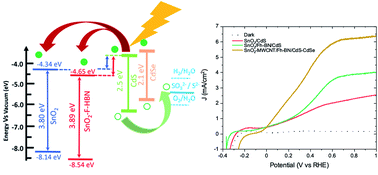Two-dimensional functionalized hexagonal boron nitride for quantum dot photoelectrochemical hydrogen generation†
Abstract
We report the design and fabrication of a heterojunction photoanode consisting of two-dimensional (2D) functionalized hexagonal boron nitride (F-h-BN) nanoflakes, introduced at the interface between SnO2 and quantum dots (QDs) (e.g. CdS and CdS–CdSe), used as a photoanode in a photoelectrochemical cell (PEC) for hydrogen (H2) generation. We highlight the effect of 2D F-h-BN nanoflakes on the carrier recombination and performance of the PEC system. In addition, the tailoring of SnO2 film thickness and incorporation of multi-walled carbon nanotubes (MWCNTs) were investigated for their effect on carrier dynamics and overall device performance. Our results show that a PEC device based on SnO2/F-h-BN/CdS QDs exhibits a 60% improvement in the saturated photocurrent density (at 1.0 V vs. RHE) compared to the control device, due to improved electron injection and reduced carrier recombination at the metal oxide/QDs/electrolyte interface. The highest saturated photocurrent density value reached 6.35 mA cm−2 (at 1.0 V vs. RHE), after thickness optimization of the SnO2 film, incorporation (0.015 wt%) of MWCNTs, and cascade CdS–CdSe QDs. In addition, the PEC system maintains 98% of the initial value of photocurrent density after four hours of continuous one sun illumination (AM 1.5G, 100 mW cm−2). Our results offer a simple yet cost-effective and efficient strategy to enhance the performance of QD based PEC H2 generation and potentially other optoelectronic devices.



 Please wait while we load your content...
Please wait while we load your content...